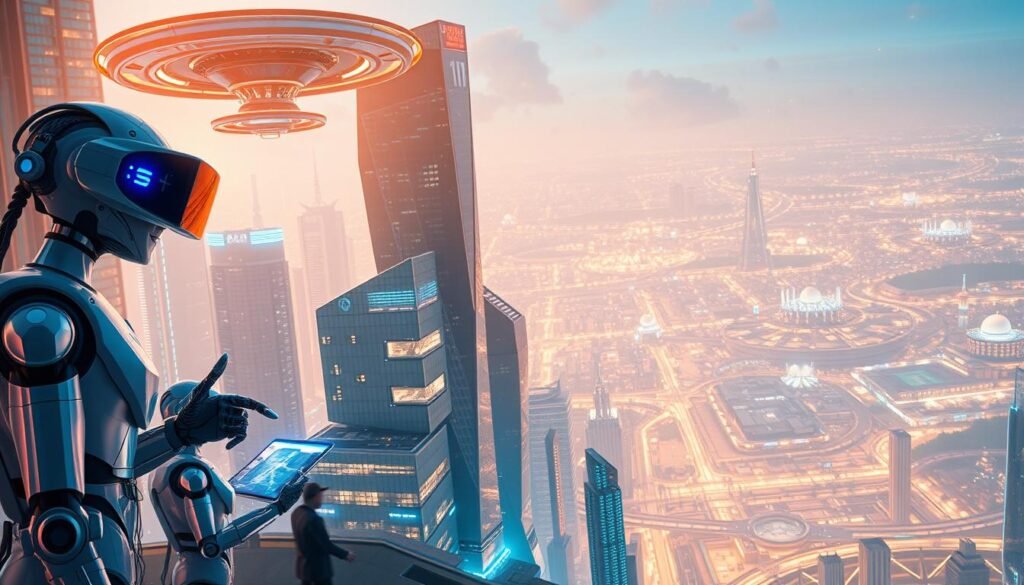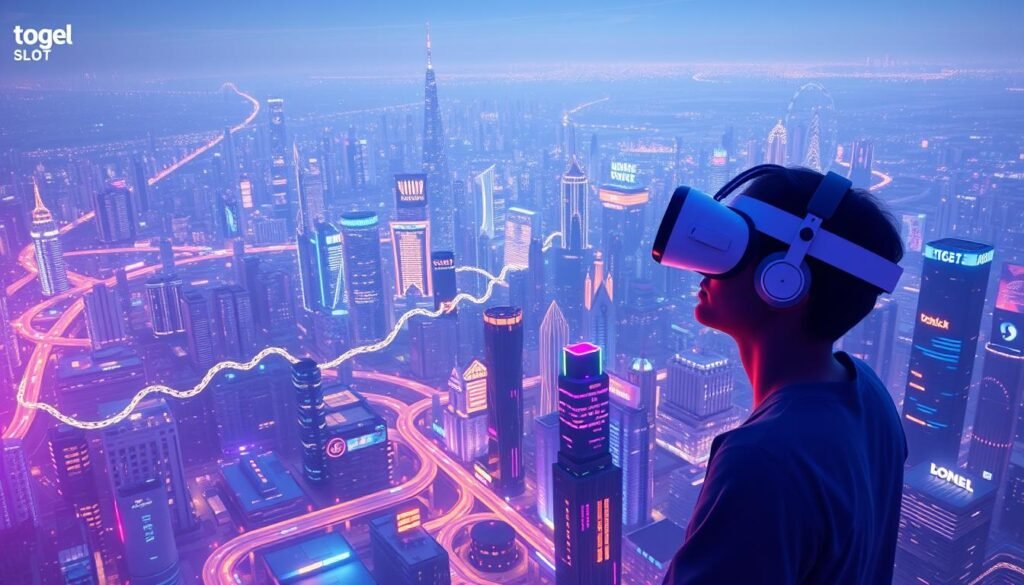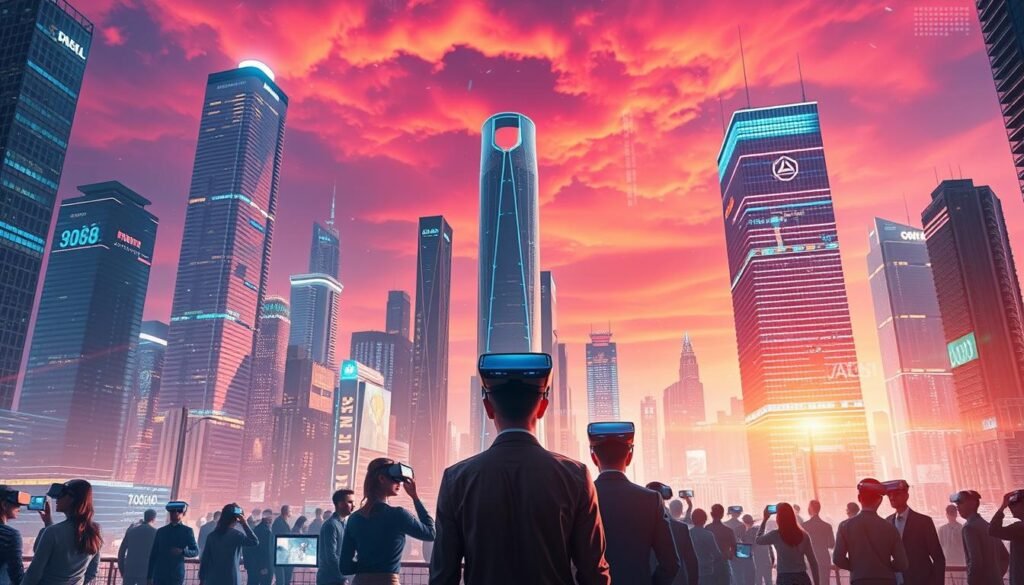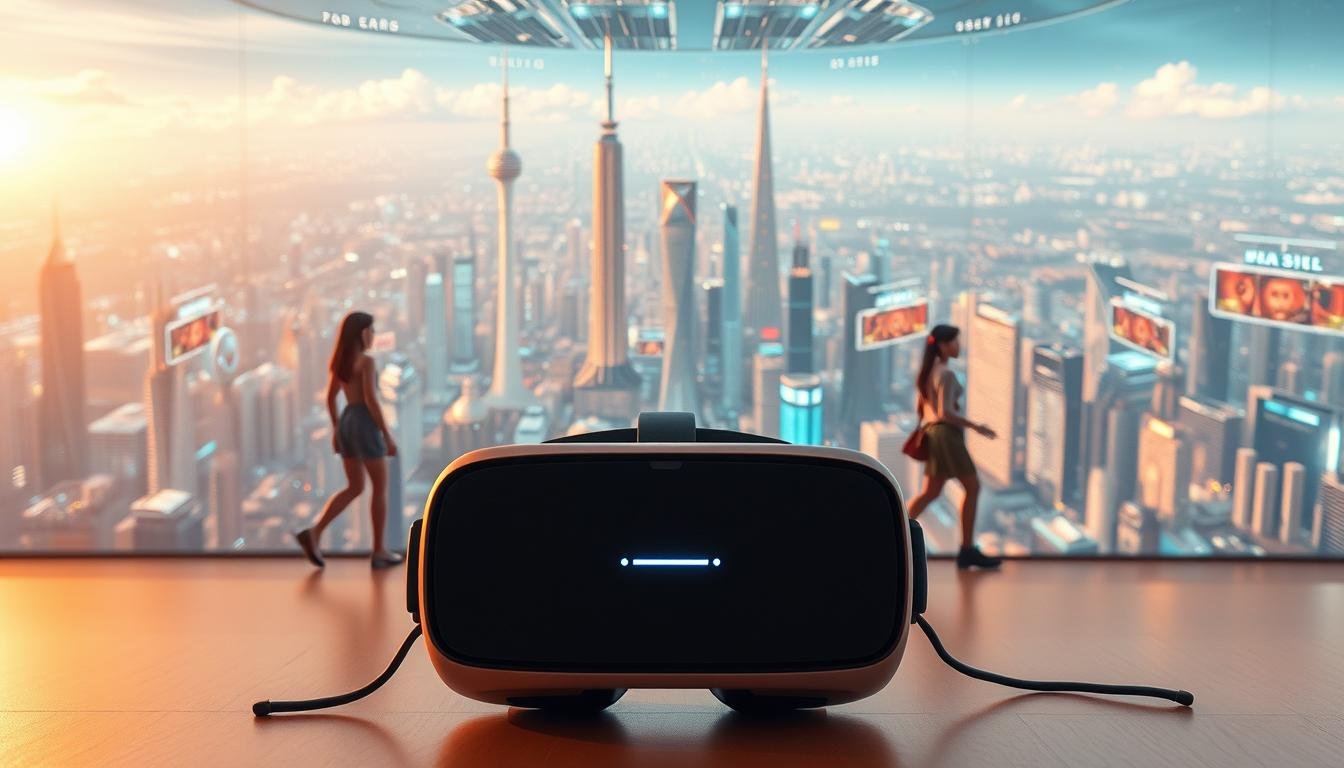Imagine stepping into a world where your reality blends seamlessly with digital experiences. This is no longer a distant dream but a rapidly evolving concept shaping our future. By 2025, immersive technologies are set to redefine how we interact, work, and connect.
Leading companies like Meta and Microsoft are at the forefront of this transformation. Their innovations in hardware and software are pushing boundaries, creating spaces where users can explore, create, and engage like never before. The integration of user data ensures personalised experiences, making these platforms more intuitive and impactful.
As these technologies advance, they promise to bridge the gap between physical and virtual worlds. From gaming to education, the applications are vast and transformative. To understand more about the platforms driving this change, explore the top metaverse platforms shaping this digital frontier.
Key Takeaways
- Immersive technologies are revolutionising digital interactions by 2025.
- Meta and Microsoft lead in creating innovative virtual experiences.
- User data integration enhances personalised digital spaces.
- Emerging hardware and software redefine connectivity.
- Applications span gaming, education, and beyond.
Introduction: Entering the Next Frontier of Immersive Technology
Step into a realm where digital landscapes redefine how you interact with technology. This next frontier of immersive innovation is reshaping our world, offering experiences that feel both real and revolutionary. Companies are leading the charge, creating environments that connect users globally.
From advanced hardware to intuitive software, these tools are unlocking new possibilities. You can now explore a virtual world that feels as dynamic as the physical one. This seamless integration is transforming how we work, learn, and play.
Pioneering firms are at the heart of this evolution. Their efforts ensure that every user enjoys personalised, engaging experiences. These innovations are not just about technology; they’re about creating meaningful connections in a digital space.
As these advancements continue, the line between physical and virtual environments blurs. This fusion promises to redefine our daily lives, making technology an even more integral part of our world.
Emerging Trends in Virtual Reality for 2025

By 2025, immersive technologies will redefine how you interact with digital spaces. These advancements are not just about gadgets; they’re about creating seamless connections between you and the world around you. From gaming to training, the possibilities are endless.
Advancements in Hardware and Software
Innovative devices are pushing boundaries. Ergonomic headsets with improved graphics and haptic feedback are transforming how you experience virtual reality. These tools are not only more comfortable but also more immersive.
Software development is keeping pace. Enhanced computer graphics and intuitive platforms are making these experiences more realistic. Whether you’re gaming or training, the level of detail is astonishing.
Evolving User Experiences and Applications
Your experience in digital spaces is becoming more personalised. Cutting-edge applications are designed to adapt to your needs, making every interaction meaningful. From virtual classrooms to simulation training, the world is your playground.
These trends are already influencing industries. For example, the NHS is investing in virtual reality training to reduce costs and improve skills. This shows how practical these advancements can be.
As technology evolves, so does your experience. The future promises a seamless blend of physical and digital realms, offering endless opportunities for exploration and growth.
Understanding VR and the Metaverse

Digital realms are evolving, blending physical and virtual experiences like never before. These advancements are not just about technology; they’re about creating a new way to interact with the world. To understand this shift, it’s essential to grasp the core concepts driving these changes.
Defining the Core Concepts
Virtual reality immerses you in a simulated environment, making it feel real. It’s a concept that has been around for decades but is now more accessible and advanced. On the other hand, the metaverse is a broader idea. It’s a collective virtual space where multiple digital environments coexist.
These environments are interconnected, allowing you to move seamlessly between them. The internet plays a crucial role here, acting as the backbone that supports these digital ecosystems. Together, these concepts are reshaping how you perceive reality.
Interconnected Digital Ecosystems
The metaverse is more than just a virtual world; it’s a network of digital spaces. These spaces are designed to be interactive and immersive, offering endless possibilities. For example, you can attend a virtual concert, explore a digital museum, or collaborate in a virtual office.
Platforms like Roblox and Decentraland are pioneering this space. They provide tools for users to create and explore their own digital environments. This interconnectedness is what makes the metaverse so powerful. It’s not just about escaping reality; it’s about enhancing it.
As these ecosystems grow, they’ll become more integrated into your daily life. From education to entertainment, the metaverse is set to redefine how you interact with the world.
Technological Innovations Shaping Immersive Worlds

Innovative devices are transforming how you experience digital spaces. These advancements are not just about gadgets; they’re about creating seamless connections between you and the world around you. From gaming to training, the possibilities are endless.
Cutting-edge Devices and Platforms
New tools are pushing boundaries in virtual reality. Ergonomic devices with improved graphics and haptic feedback make experiences more immersive. These innovations are not only comfortable but also highly engaging.
Software development is keeping pace. Enhanced computer graphics and intuitive platforms create realistic simulations. Whether you’re gaming or training, the level of detail is astonishing.
Advancements in Augmented Reality and Design
Augmented reality is evolving rapidly. Integration with design principles ensures that digital elements blend seamlessly with the physical environment. This creates a more cohesive and interactive experience.
Platforms like Unity are leading the way. Their Universal Render Pipeline improves visual quality, making AR/VR experiences more lifelike. These tools are accessible across devices, from mobile to high-fidelity systems.
Real-world Applications
Companies are leveraging these innovations to enhance user engagement. For example, the NHS uses virtual reality for training, reducing costs while improving skills. This shows how practical these advancements can be.
| Technology | Application |
|---|---|
| Augmented Reality | Enhanced training simulations |
| Virtual Reality | Immersive gaming experiences |
| Design Integration | Seamless digital-physical blending |
These innovations are reshaping how you interact with the world. They bridge the gap between physical and virtual spaces, offering endless opportunities for exploration and growth.
Corporate Adoption and Business Strategies in the Metaverse

Businesses are embracing immersive technologies to redefine their strategies and customer interactions. The metaverse is no longer a futuristic concept but a practical tool for innovation. Leading organisations are leveraging these advancements to stay ahead in a competitive market.
Case Studies from Leading Organisations
Walmart has integrated virtual reality into its training programmes. Employees can now practice scenarios in a virtual world, improving skills and efficiency. This approach has reduced costs while enhancing performance.
Zillow, a real estate platform, uses design tools to create immersive property tours. Buyers can explore homes remotely, saving time and resources. This innovation has transformed how people engage with real estate listings.
Facebook and Microsoft are investing heavily in the metaverse. Their platforms enable businesses to host virtual events and meetings. These initiatives are reshaping how companies connect with their audiences.
Transforming Customer Engagement
Brands are using virtual reality to create personalised experiences. For example, fashion retailers offer virtual try-ons, allowing customers to visualise outfits before purchasing. This enhances satisfaction and reduces returns.
Training simulations are another key application. Companies like the NHS use these tools to improve employee performance. Such practical use of technology demonstrates its value across industries.
By integrating metaverse applications, businesses can enhance their brand presence. These strategies not only attract customers but also foster loyalty. The future of business lies in innovative digital engagement.
- Walmart uses virtual reality for employee training.
- Zillow offers immersive property tours in the metaverse.
- Facebook and Microsoft lead in hosting virtual events.
- Fashion retailers provide virtual try-ons for customers.
- Training simulations improve skills in various industries.
Social and Cultural Impacts of Virtual Environments

The rise of immersive spaces is transforming cultural and social dynamics. These digital environments are not just tools for entertainment; they are reshaping how we connect, interact, and perceive the world. From fostering empathy to bridging geographical divides, their influence is profound.
Enhancing Digital Connectivity
Immersive platforms are revolutionising how you engage with others. They create opportunities for meaningful interactions, even across vast distances. For instance, virtual reality enables you to attend events, collaborate on projects, or simply socialise in ways that feel authentic.
These experiences foster empathy and understanding. By stepping into another person’s shoes, you gain insights into diverse perspectives. This is particularly valuable in education and training, where immersive simulations enhance learning outcomes.
Challenges in Adoption and Accessibility
Despite their potential, these technologies face hurdles. Not everyone has equal access to the necessary tools. The digital divide remains a significant barrier, particularly for older adults or those in underserved communities.
Cultural perceptions also play a role. Some view virtual spaces as isolating, while others see them as liberating. Bridging these perspectives requires thoughtful design and inclusive policies. Companies must ensure their services cater to diverse needs.
| Aspect | Impact |
|---|---|
| Social Connectivity | Enhanced global interactions |
| Cultural Understanding | Fosters empathy and inclusivity |
| Accessibility |
As these environments evolve, they promise to enrich your life in countless ways. However, addressing challenges like accessibility and cultural acceptance is crucial for their widespread adoption. By doing so, we can ensure these technologies benefit everyone, not just a select few.
Navigating the Challenges of Future Developments

As immersive technologies evolve, they bring both opportunities and challenges. While they promise to revolutionise how you interact with digital spaces, they also raise critical concerns. From data privacy to economic barriers, these hurdles must be addressed for sustainable growth.
Data Privacy and Security Concerns
One of the most pressing issues is safeguarding datum. As these platforms collect vast amounts of user information, ensuring its protection becomes paramount. Breaches can lead to significant consequences, eroding trust in metaverse tech.
For example, recent incidents have highlighted vulnerabilities in virtual reality platforms. Companies must invest in robust security measures to mitigate risks. This includes encryption and transparent data policies.
Economic and Technological Barriers
Deploying advanced solutions requires significant investment. Many industry players face financial constraints, slowing the adoption of cutting-edge tech. Additionally, technological limitations can hinder scalability.
For instance, developing high-fidelity augmented reality experiences demands substantial resources. Smaller firms may struggle to compete, creating disparities in the industry.
To overcome these challenges, collaboration is key. Governments, industry leaders, and tech innovators must work together. By addressing these issues, we can ensure a more inclusive and secure future for immersive technologies. For a deeper dive into these challenges, explore this comprehensive analysis.
Conclusion
The fusion of physical and digital realms is reshaping how you perceive and engage with technology. Emerging trends in virtual reality and mixed reality are creating seamless experiences that bridge gaps between these spaces. From personalised avatars to immersive virtual worlds, these innovations are transforming industries and cultures alike.
Businesses are leveraging these advancements to enhance product offerings and service delivery. Cultural landscapes are also evolving, with digital environments fostering global connections. This synergy between realities is not just a concept; it’s a tangible shift in how you interact with the world.
Looking ahead, these technologies promise to redefine daily life. Staying informed about these developments is crucial. For deeper insights, explore the evolving frontier of virtual spaces. The future is here, and it’s more immersive than ever.
FAQ
What is the difference between virtual reality and the metaverse?
How will advancements in hardware and software shape immersive experiences by 2025?
What role do businesses play in the development of the metaverse?
What are the social and cultural impacts of virtual environments?
What are the main challenges in the future development of immersive technology?
How can users prepare for the future of virtual reality and the metaverse?
Source Links
- Can Meta still make the metaverse?
- AWE 2025 Speakers Include Oculus Founder, Meta’s VP of Metaverse Experiences, & ILM Immersive VP
- Are We Ready for the Metaverse? Implications, Legal Landscape, and Recommendations for Responsible Development – Digital Society
- Navigating the ethical landscape of the metaverse: Challenges and solutions
- Meta doubles down on the Metaverse in a make-or-break 2025
- Big XR News from Meta, SynergyXR, NHS – XR Today
- Council Post: Meet The Metaverse: Practical Business And Social Applications
- How the NHS is approaching the future of XR and metaverse technologies
- Unity’s Role in Shaping the AR/VR Landscape: A Post-Apple Evolution
- Best Metaverse Games to Enjoy in 2025 – Metana
- Metaverse Integration: How Businesses Can Leverage Virtual Spaces for Growth
- Is Metaverse the Next Big Disruption, and How Can IT Leadership Prepare to Benefit from It?
- Is Your Business Ready for the Metaverse? Here’s the Truth – Wisegen Pvt Ltd
- Social presence in shared virtual reality experience among older adults – Virtual Reality
- The many ways AI can empower XR | Computer Weekly
- The irresistible marriage of AI and XR | Computer Weekly
- Hindrances to the Utilisation of the Metaverse for Net-Zero Buildings in South Africa
- Advertising in the Metaverse: A New Frontier for Brands
- Does Mindfulness Mediated by Virtual Reality Help People with Functional Diversity?
- Metaverse in E-commerce Market Poised for Transformative growth, to a Remarkable USD 255.8 Billion by 2033
